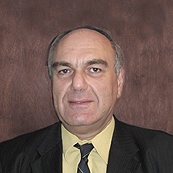Staff Report

Dr. Levon Chookaszian, UNESCO Chair of the Department of Art History at Yerevan State University, Armenia, has been appointed the sixth Henry S. Khanzadian Kazan Visiting Professor in Armenian Studies at Fresno State for the Fall 2006 semester.
Dr. Chookaszian is teaching a three-unit course, Armenian Studies 120T, “Armenian Massacres and Genocide Reflected in Armenian Art of the 20th Century,” which is offered on Tuesday and Thursday afternoons from 2:00-3:15 PM. The course is illustrated with slides. This is the first time such a course has been offered anywhere in the world.
Teaching the course gives Dr. Chookaszian a chance to reflect about it in a classroom setting, after writing about the topic for so long. He became interested in the topic because his family includes genocide survivors, and also because during many years of research he has discovered more and more artists connected to the subject. He has found dozens and dozens of Armenian painters, who have utilized Genocide in their work, and many non-Armenian painters have been concerned about the massacres, such as Jean-Louis Forain and Thèophile Alexandre Steinlen.
The Armenian Massacres of 1895-96 and of 1905-1907 stimulated the appearance of topics related to those events in the works of Armenian painters. The first artist who represented the acts of violence and ethnic cleansing was Haroutyune Shamshinian (18561914). Later on numerous Armenian artworks were produced by different artists depicting those horrible pages of Armenian modern history.
During the Armenian Genocide of 1915-1923, certain painters became the eyewitnesses of the deportation of the Armenian people from their native lands and portrayed those homeless people, sometimes even endangering their own lives.
The mass tragedies of those years created the generations of orphan painters who grow up in orphanages in foreign countries and produced art-works full of sadness and nostalgia, until the end of their lives. The horrors that they experienced, in certain cases, were incorporated in symbolic or surrealistic ways.
As Kazan Visiting Professor Dr. Chookaszian has had the opportunity to spend more time in research, particularly on the subject that he is now teaching. He has been impressed by Fresno State, especially with the organization of “smartrooms,” rooms which have been especially well equipped with technical means. He has also been impressed with the faculty on campus, finding them to be intellectually very interesting. Students in Armenia are more connected to reading than with digital sources and in Armenia they have no opportunities to have access to libraries. Students in Armenia do not have the facilities for learning utilizing new technology.
Dr. Chookaszian did his undergraduate work in Armenian language and literature and his graduate work in Armenian art at Yerevan State University. He furthered his graduate studies at Moscow State University with special emphasis on Byzantine art and European art of the Middle Ages. His first doctoral degree in art history was defended at the Art Institute of the Georgian Academy of Sciences, Tbilisi (1981), while he received his second doctorate in the field from the Institute of Art of the Ministry of Culture of Russia, Moscow (2001).
Dr. Chookaszian is an expert on Armenian illuminated manuscripts of the Middle Ages and has recently finished a monograph on the 13th century Armenian painter, Toros Roslin, the most outstanding painter of medieval Armenia. He has also published a monograph on Grigor the Miniaturist. For many years Dr. Chookaszian has been a Senior Fellow and Professor of Armenian Art at the Center for Armenian Studies at Yerevan State University, and a member of the National Committee of UNESCO in Armenia.
Dr. Chookaszian is the author of more than 200 articles and reviews for scholarly journals and newspapers as well as numerous entries for encyclopedias. He is also the recipient of several prestigious grants that have helped him pursue his research in Armenian art history.
Dr. Chookaszian has participated in many international congresses and symposia on the topic of Armenian, Georgian, Russian, Persian, and Byzantine Art. He is fluent in Armenian, Russian, English, French, and German. He and his brother Garegin are the initiators of an Armenian Art Database.
 Hye Sharzhoom Armenian Action
Hye Sharzhoom Armenian Action